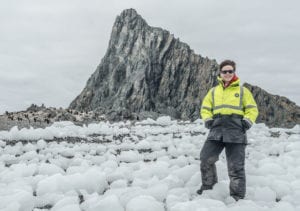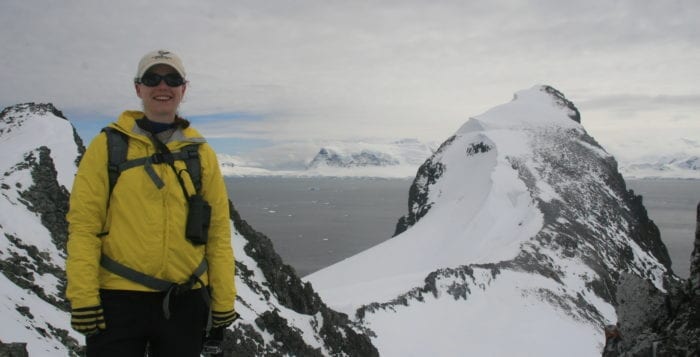By Daniel Dunaief
Counting penguins is like riding the highs and lows of Yankees rookie Aaron Judge’s home run streaks, followed by his series of strike outs. He’s not as bad as his strike outs suggest, although he’s also not a sure thing at the plate either.
Similarly, in local populations, the Adélie penguin, which waddles to and fro squawking on land and gliding gracefully through the water, isn’t as clear a barometer of changes in the environment. Also, like Judge, when populations rise and fall, people are eager to offer their explanations for exactly what’s happening, even if the sensational explanations — he’s not that good, no, wait, he’s the greatest ever — may overstate the reality.

“We have to be careful not to be overreactive,” said Heather Lynch, an associate professor of ecology and evolution at Stony Brook University. “The concern is that, when we see increases or decreases, the implication is that there’s a miraculous recovery or a catastrophic crash.”
That, however, is inconsistent with Lynch’s recent results, which were published in the journal Nature Communications. Examining penguin data from 1982 to 2015, Lynch, Christian Che-Castaldo, who is a postdoctoral researcher in Lynch’s lab, and nine other researchers looked to see if there’s a way to connect the size of the population to changes in the environment. The study involved two teams of researchers, one supported by NASA and the other backed by the National Science Foundation.
“It’s a noisy system,” Lynch concluded. Managers of the populations of krill, small crustaceans that are the mainstay of the Adélie diet, try to use time series of key indicator species to understand what’s going on in the marine realm. In this article, Lynch said, local Adélie penguin populations may not be a clear signal of the health of the krill stocks because penguin abundance fluctuates for reasons she and her team couldn’t pinpoint.
These penguins, which Lynch has counted during her field work in the Antarctic, exhibit changes in population that can run contrary to the health, or stressed condition, of the environment.
“You can’t have your finger on the pulse” with the available data, Lynch said. “Part of our inability to model year-to-year changes is because we can’t measure the right things in the environment.”
The drivers of abundance fluctuations likely involve other animals or aspects of the krill fisheries they couldn’t model, she suggested.
“There’s a lot we don’t know about what penguins do under water, where they spend a large portion of their time and where they feed,” Grant Humphries, who was in Lynch’s lab for a year and now runs his own data science company in Scotland called Black Bawks Data Science Ltd, explained in an email. “The signals that drive year to year changes might actually lie there.”
Tom Hart, a researcher of the Department of Zoology at the University of Oxford who was not involved in this study, explores local scale variation in penguin populations. Locally, Hart said in an interview by Skype, “Things are incredibly noisy. When you aggregate, you get good signals, but with some error.” He suggested that this research drives him on further, showing that “local influences are important” because there’s so much variance left to explain. Lynch’s research is “a really good study and shows very well what’s happening on the regional scale, but leaves open what happens below that,” he said.
Indeed, Lynch suggested that by putting sites together, researchers can look at larger areas, which provide a clearer picture on shorter time scales.
Michael Polito, an assistant professor in the Department of Oceanography and Coastal Sciences at Louisiana State University who was not involved in the study, suggests that this extensive analysis indicates that “you can still look at the relationship between the abundance of penguins and the environment in a robust way. Even though any individual time series may not be the best way to understand these relationships, in the aggregate you can use them.”
Managers who set fishery policies in Antarctic waterways are often concerned about harvesting too much krill, leaving the penguins without enough food to survive and feed their chicks.
The challenge with this result, Lynch acknowledges, is that it makes setting krill boundaries more difficult.
A strategy that involves resetting conservation targets based on annual monitoring appears unrealistic given these results, Lynch said. “From a practical standpoint, we threw in everything we could and could explain only a tiny fraction of the variation,” she said.
Hart added that this is “not an argument to fish away,” he said. “We need to understand what’s going on at a local scale and we’re not there yet.”
To get people involved, Lynch and her team created a science competition, called Random Walk of the Penguins, to see who could predict the overall penguin populations for Adélie, gentoo and chinstrap penguins from the 2014 to 2017 seasons.
The competition, which was a collaborative effort with Oceanites, Black Bawks Data Science and Driven Data included $16,000 in prize money, which was donated by NASA. Entrants could use data from the 1982 through the 2013 seasons. The contest drew competitors from six continents. Of the five winners, all were from different countries.
Humphries, who was the lead on the data science computation, said the results were “somewhat humbling” because competitors were able to make “decent predictions” using only the time series. “With long-term predictions and for determining the tipping points, there is still a lot of work to be done.”
Lynch is relieved that her co-authors supported the direction the article took. “I’m a skeptic by nature and more than happy to throw orthodoxy (or even my own previous work) under the bus,” she wrote in an email. “I do hope that others will use our model as a starting point and we’ll never go back to the old days where everyone looked only at ‘their sites.’”





